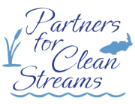 If December’s weather is any indication of the winter we will have this year, it will be quite snowy and cold! To combat this climate, municipalities and homeowners often employ the use of salt to de-ice roads and sidewalks. While this certainly can make it safer for the public, it often creates a dangerous situation for our rivers, streams, lakes, and ground water. Once the snow has melted, the salt and other chemicals used to de-ice roadways leaches into the waterways, changing the pH balance and becoming a permanent pollutant. The Univesity of Wisconson-Madison recently featured an article detailing the effect road salt is having on our Great Lakes (click here to read). The only way to remove salt (chloride) is through reverse osmosis, a challenging and costly treatment process. Unfortunately, there are not environmentally safe, effective, and inexpensive alternatives to salt. This means, reducing salt in our waterways means reducing salt at the application source.
If December’s weather is any indication of the winter we will have this year, it will be quite snowy and cold! To combat this climate, municipalities and homeowners often employ the use of salt to de-ice roads and sidewalks. While this certainly can make it safer for the public, it often creates a dangerous situation for our rivers, streams, lakes, and ground water. Once the snow has melted, the salt and other chemicals used to de-ice roadways leaches into the waterways, changing the pH balance and becoming a permanent pollutant. The Univesity of Wisconson-Madison recently featured an article detailing the effect road salt is having on our Great Lakes (click here to read). The only way to remove salt (chloride) is through reverse osmosis, a challenging and costly treatment process. Unfortunately, there are not environmentally safe, effective, and inexpensive alternatives to salt. This means, reducing salt in our waterways means reducing salt at the application source.
So, here are some tips to keep you and your waterways safe this year:
- Shovel more! Yes, this requires more manually labor, but it reduces the need for salt and is more effective at removing snow from sidewalks and roadways.
- Do not apply salt when it is below 15 degrees. At this temperature, most salts stop being effective as de-icers. You can use sand instead to help with traction.
- Drive Safe. Drive for various winter conditions and make sure to be cautious of snow plow operators. Buying winter tires can help with traction as snow and ice accumulate.
- Make sure you are not over-applying. Give salt time to work before adding more.
- Apply less. More salt does NOT mean more melting
- Use 4 lbs of salt per 1000 square feet
- One pound = 12 oz. coffee cup
- Leave 3 inches of space between granules
- Use a spreader to help with consistent spreading
- Use 4 lbs of salt per 1000 square feet
- Sweep up extra salt. If it is visible on dry pavement, it is no longer working for its intended purpose and will end up in our water system.
By following these salting tips, we can limit the amount of chloride pollution that enters our streams, rivers, and lakes during winter months. Smart application of salt can make it safer for you as snow and ice arrive and safer for your waterways this Spring. Make a vow to go low-sodium this year!
